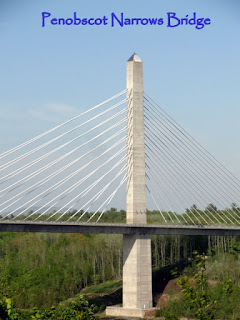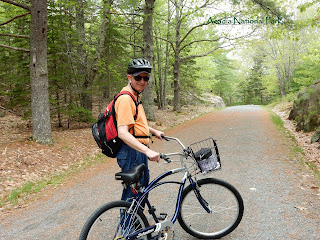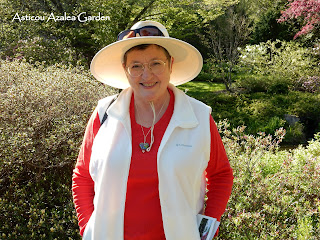Little did I know at one of Sarah's graduation parties I would meet someone who grew up in Maine, and he would give me insight into who these people are. He talked freely about the mindset of 'year rounders'. First, it's about doing anything and everything to make a living here. Life is very day to day. Most people we've either met or observed, especially on Vinalhaven Island, didn't have one job - they had several. It is a constant challenge to make enough money to get through the year as well as battle winter. It is so cold here for so long winter is, in fact, a battle for survival even with the modern conveniences of the 21st century. Never having lived in a cold climate, this startled me.
Then, there are the limbo people who we've seen in every super-tourist town. (Bar Harbor certainly qualifies because it's the service town to a heavily visited national park.) In Bar Harbor the people who have served us are A-B people. (In Sun City, we call people who live one-half of the year in AZ and one-half of the year in another fixed place A-B people because each year they travel from A to B and back again.) Well, in the 'tourist' areas of Maine, people work seasonally. They live in Bar Harbor or Booth Bay or wherever tourists congregate for the season, and then, they live elsewhere (such as Portland or Boston or even back home in Jamaica) for the rest of the year.
Until 1947, Bar Harbor was like Newport; it was the summer playground of the wealthy. They built gigantic opulent homes and came to Bar Harbor for the summer to escape the heat of Boston and New York and socialize. There was a 'millionaire's row' similar to Newport, Rhode Island. Down Highway 3 just outside of the sleepy fishing town of Bar Harbor was one magnificent estate after another. In 1947 a devastating fire destroyed fully one-half of Bar Harbor and burned most of the homes on millionaire's row as well as 23,000 acres of Acadia National Park. Most of these mansions were never rebuilt due to postwar changes in culture and lifestyles, as well as the tax laws. The town of Bar Harbor reinvented itself as a summer destination for ordinary people. In place of the estates were built a row of motels to house the new middle class summer visitors, and many large homes left were transformed into bed and breakfast establishments for the upper middle class as they all visited the national park, and thus the tourist town of Bar Harbor as it is today was born.
 The other side of the Maine coin are the 'summer people'. There are still some large vacation homes dotted all around Mount Desert Island as well as Vinalhaven. (Yes, this place is also an island, but a very large one unlike Vinalhaven.) Bar Harbor is but one town of many on this island. Southwest Harbor, another Mount Desert town, and Vinalhaven are still obviously filled with homes of wealthy people who come to Maine for the entire summer, or in some cases for a few weekends. The example of these people are the Bushes who 'summer' in Kennebunkport. Other families, not quite so famous, with their vacation homes are replicated throughout the coastal areas of Maine. These summer people, or more specifically the HOUSES of summer people allow the year rounders to continue working through the winter maintaining and caretaking those houses. There's a certain tension caused by the changes to island life these temporary people impose upon the year-rounders.
The other side of the Maine coin are the 'summer people'. There are still some large vacation homes dotted all around Mount Desert Island as well as Vinalhaven. (Yes, this place is also an island, but a very large one unlike Vinalhaven.) Bar Harbor is but one town of many on this island. Southwest Harbor, another Mount Desert town, and Vinalhaven are still obviously filled with homes of wealthy people who come to Maine for the entire summer, or in some cases for a few weekends. The example of these people are the Bushes who 'summer' in Kennebunkport. Other families, not quite so famous, with their vacation homes are replicated throughout the coastal areas of Maine. These summer people, or more specifically the HOUSES of summer people allow the year rounders to continue working through the winter maintaining and caretaking those houses. There's a certain tension caused by the changes to island life these temporary people impose upon the year-rounders.  Overall, Maine has been interesting. Acadia National Park doesn't have the visual drama of the western parks, but we got a bonus: It's Spring! Everything is in bloom, and all the trees have that beautiful soft vibrant spring green which only lasts for a few weeks. It's so early here there are some trees still without leaves. Ominously, the bugs are just starting to come out. This place is full of pools and fens and marshes; it is mosquito and tick heaven. Their are two great things about this park. First, the juxaposition of mountain and sea, and second, the carriage roads. These are gravel roads built by John D. Rockefeller, Jr. around the 'sights'. They are no bicycle and walking roads on which you can enjoy riding a bicycle or walking without dodging cars. This makes Acadia unique in that older people and people with disabilities can access this park.
Overall, Maine has been interesting. Acadia National Park doesn't have the visual drama of the western parks, but we got a bonus: It's Spring! Everything is in bloom, and all the trees have that beautiful soft vibrant spring green which only lasts for a few weeks. It's so early here there are some trees still without leaves. Ominously, the bugs are just starting to come out. This place is full of pools and fens and marshes; it is mosquito and tick heaven. Their are two great things about this park. First, the juxaposition of mountain and sea, and second, the carriage roads. These are gravel roads built by John D. Rockefeller, Jr. around the 'sights'. They are no bicycle and walking roads on which you can enjoy riding a bicycle or walking without dodging cars. This makes Acadia unique in that older people and people with disabilities can access this park. |
| Drake on a Carriage Road |
Another surprise here were the azaleas! I had no idea azaleas could grow here. The plants here, while looking very similar to Gulf Coast azaleas are totally different plants - mostly Japanese azaleas which can handle the extreme cold of the winter months.
 |
| Flowering crabapple tree |
 |
| Azaleas at Asticou Azalea Garden |
Tomorrow, on to Canada. I've very excited about that prospect since we have done extensive planning on a scale which would have daunted us had we but known how much work there would be. Oh, and FYI, if you want to reach me, please email since I will not be using my iphone for anything except emergency calls while I'm in Canada.
